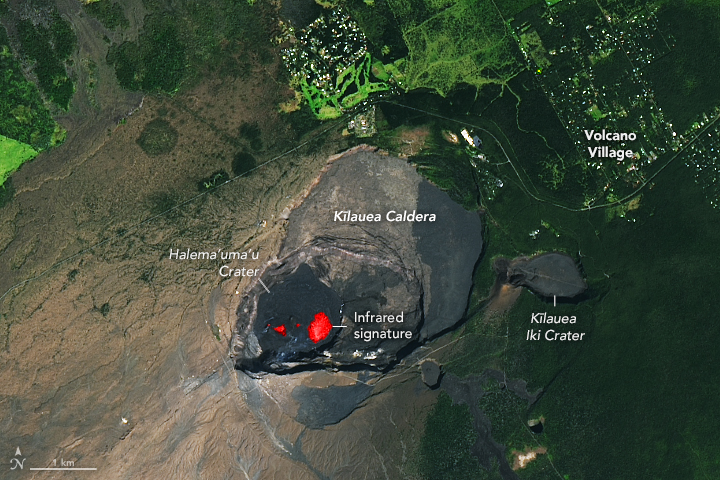
Kilauea Glows
Downloads
- kilauea_oli_2023011_lrg.jpg (1277x1030, JPEG)
- kilauea_usgs.jpg (720x540, JPEG)
Metadata
- Sensor(s):
- Landsat 8 - OLI
- Data Date: January 11, 2023
- Visualization Date: January 13, 2023
Just after 4:30 p.m. local time on January 5, 2023, Kilauea—Hawaii’s youngest and most active volcano—began erupting once again. Scientists at the U.S. Geological Survey’s Hawaiian Volcano Observatory saw a glow in summit webcam images indicating that the eruption had resumed. They detected fissures at the base of Halema‘uma‘u crater, within the summit caldera, which generated lava flows.
Multiple fountains of lava became active in Halema‘uma‘u crater on the afternoon of January 5. One large burst of lava reached 50 meters (164 feet) high and covered the crater floor with lava. By evening, lava had spilled across the crater at depths of about 10 meters (32 feet).
The Operational Land Imager (OLI) on Landsat 8 acquired this image on January 11, 2023. The image is a composite of natural-color (bands 8, 4, 3, and 2) overlaid with false-color (bands 6, 5, and 3) to highlight the infrared (red) signature of the lava. At the time of acquisition, eruption activity on Kilauea’s caldera was concentrated in a large lava lake in the eastern half of Halema‘uma‘u crater, as well as a smaller area of lava in the western half of the crater.
Volcanic activity on Kilauea is common. A recent eruption generated a lake of lava that lasted from September 29, 2021, to December 9, 2022. The image below shows an aerial view of the new eruption within Halema‘uma‘u crater on the morning of January 6, 2023. Mauna Loa, Hawaii’s largest active volcano, is illuminated in the background.

The day after Kilauea reawakened, Mauna Loa stopped erupting. Although the two volcanoes are not physically connected, they are part of the same hotspot system. Their volcanic activity may be influencing one another in some way.
“When Mauna Loa is frequently active, Kilauea tends to be less active, and vice versa,” Jim Kauahikaua, a volcanologist with the Hawaiian Volcano Observatory, told the New York Times. Kauahikaua added that this relationship is somewhat speculative given the limited scope of recorded data.
Kilauea has erupted almost continuously from 1983 until 2018, when a months-long eruption created slow-moving lava flows that destroyed around 700 homes. Since the 2018 eruption, Kilauea has been erupting sporadically. These recent eruptions have been contained within the Halema‘uma‘u crater as lakes of lava.
References & Resources
- NASA Earth Observatory (2018, May 17) Kilauea Continues to Erupt. Accessed January 13, 2023.
- NASA Earth Observatory (2022, November 30) Mauna Loa Awakens. Accessed January 13, 2023.
- National Park Service (2023, January 6) Safety and species preservation are key for new Kilauea eruption. Accessed January 13, 2023.
- The New York Times (2023, January 6) Hawaii Volcano Kilauea Erupts Again After Weekslong Pause. Accessed January 13, 2023.
- The New York Times (2022, November 28) Mauna Loa Volcano in Hawaii Erupts for the First Time in Nearly 40 Years. Accessed January 13, 2023.
- U.S. Geological Survey’s Hawaiian Volcano Observatory (2023, January 7) Photo and Video Chronology—Hawaiian Volcano Observatory—January 6, 2023. Accessed January 13, 2023.
- U.S. Geological Survey’s Hawaiian Volcano Observatory Daily Updates—Kilauea Volcano. Accessed January 13, 2023.
NASA Earth Observatory image by Lauren Dauphin, using Landsat data from the U.S. Geological Survey. USGS photograph by K. Lynn. Story by Emily Cassidy.
This image record originally appeared on the Earth Observatory. Click here to view the full, original record.